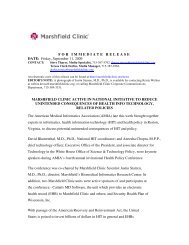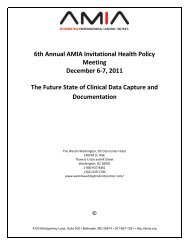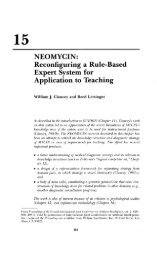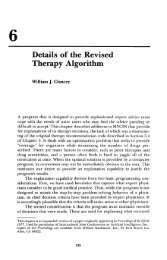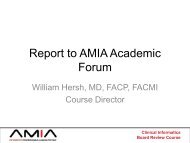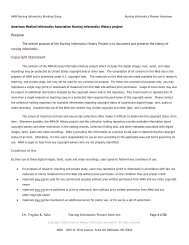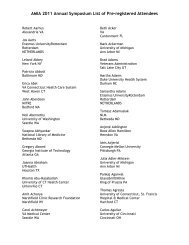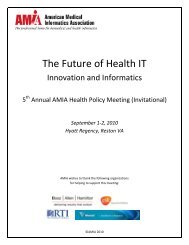7th Annual AMIA Invitational Health Policy Meeting December 12-13 ...
7th Annual AMIA Invitational Health Policy Meeting December 12-13 ...
7th Annual AMIA Invitational Health Policy Meeting December 12-13 ...
You also want an ePaper? Increase the reach of your titles
YUMPU automatically turns print PDFs into web optimized ePapers that Google loves.
<strong>Health</strong> Data Use, Stewardship, and Governance: Ongoing Gaps and Challenges<br />
<strong>7th</strong> <strong>Annual</strong> <strong>AMIA</strong> <strong>Invitational</strong> <strong>Health</strong> <strong>Policy</strong> <strong>Meeting</strong><br />
<strong>December</strong> <strong>12</strong>-<strong>13</strong>, 20<strong>12</strong><br />
Examples of Current Data Use Projects and Activities<br />
This matrix highlights selected case studies that feature various examples of data use and data sharing activities. They include<br />
federal and state government projects; public/private collaborations; university-based projects; programs managed by research<br />
consortia, regional collaboratives, federated networks, and integrated health systems; a multi-drug company initiative; and projects<br />
working with non-traditional data sources. The information for many of the entries in the matrix was obtained directly from project<br />
representatives who responded to <strong>AMIA</strong> requests for this information or the information was collected directly from the projects’<br />
websites. These projects are intended as examples of the many data use and data sharing efforts in progress today in the fields of<br />
comparative effectiveness research, healthcare quality improvement and cost reduction, and public health monitoring and<br />
improvement. The inclusion of several projects focusing on non-traditional data is intended to provide a hint of the intriguing<br />
potential of new data sources such as mobile apps and social media that engage patients and consumers in their own health care,<br />
and take advantage of real-time, patient-entered/patient-generated data in the pursuit of research.<br />
Project Overview Purpose/Type of Data Project Features Results Challenges<br />
OMOP. Observational Medical Outcomes Partnership.<br />
Congress mandated FDA to develop open/accessible risk<br />
identification and analysis system for drug safety;<br />
research and products are in public domain. Managed<br />
by Foundation for NIH; chaired by FDA; supported by<br />
consortium of pharmaceutical research organizations;<br />
participants include academia, industry, providers and<br />
other stakeholders. 1<br />
Data management &<br />
computational infrastructure.<br />
Methodological<br />
research on effective<br />
analysis of EHR data to study<br />
effects of medical products.<br />
Claims and EHR data (deidentified);<br />
80 million<br />
patients.<br />
Focus on harmonization of<br />
disparate data. Makes<br />
available tech tools: library<br />
of health outcomes and<br />
methods, standard<br />
vocabulary, data<br />
characterization tools.<br />
Facilitates methodological<br />
research by enabling<br />
methods that can be applied<br />
to produce comparable<br />
results across different data<br />
sources. Building community<br />
of experts leading<br />
development of open source<br />
analytic framework for data<br />
model/vocabulary mappings.<br />
� Limited availability of staff<br />
trained in medical<br />
vocabularies, data<br />
standards<br />
� Many vocabulary standards<br />
exist in data sources and<br />
mapping strategies are<br />
needed<br />
� Secondary use of<br />
vocabularies presents<br />
licensing challenges



